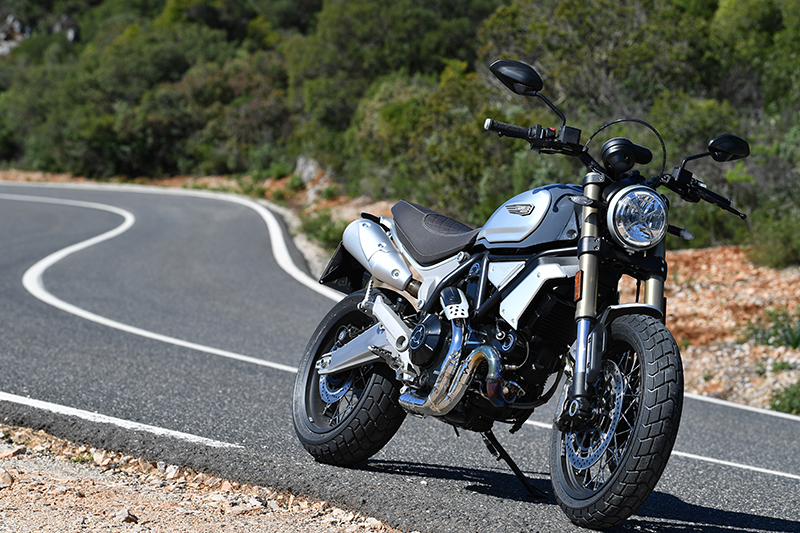2018 Ducati Scrambler 1100 Special

First Ride Review
In 2015, Ducati rolled out its new Scrambler “lifestyle brand” that began with four 803cc models—Icon, Classic, Urban Enduro and Full Throttle. The model family grew to include a friendly 399cc version called the Sixty2, and other 803cc models like the Café Racer and Desert Sled. This adventure proved a huge success, selling more than 46,000 units to date worldwide, making further upward expansion of the Scrambler family inevitable.
Sure enough, at last November’s EICMA show we got a first glimpse at the 2018 Scrambler 1100. Now we’ve not only seen the 1100 in the flesh, but also had a chance to climb aboard this new Scrambler family flagship. Recently, Ducati invited us to Lisbon, Portugal, for a one-day ride of about 120 miles—just enough to develop a firm idea of what this new top-of-the-line Scrambler is all about. We rode the Special, the middle-priced model of the three Scrambler 1100 variants, which includes a standard model and the Sport.
The heart of the Scrambler 1100 is a 1,079cc, air/oil-cooled, 90-degree L-twin with two valves per cylinder that originated in Ducati’s Monster 1100 Evo, but morphed into something that is, for practical purposes, essentially new. Packed with up-to-date features such as throttle-by-wire, three riding modes, four-setting traction control (which can be disabled), cornering ABS (always on), big twin Brembo disc brakes up front and more, this is a modern motorcycle retaining some of the old-time vibe that pays homage to the company’s long-distant single-cylinder scramblers. But let’s get real; as with all of today’s scrambler-styled bikes, nobody’s going to enter one of these things in Hare Scrambles races. In truth, the Scrambler 1100 is a pure street bike—and a very good one at that.
Ducati aimed its first two stabs within the Scrambler market at entry-level newbies and riders short in the inseam, a smart move considering the brand’s broad and strong array of big-inch bikes. But such dedication to beginner amenities necessarily imposed some significant compromises in design and cost with their first Scramblers, and therefore compromises in sophistication and performance. Tasked with crafting the alpha dog for the Scrambler pack, Ducati designers and engineers in Bologna enjoyed greater freedom in designing a larger-displacement Scrambler that carries a strong family resemblance while offering a big leap forward in function. With the needs of beginning riders out of the mix, the 1100 grew taller, longer and heavier than the Scrambler 800—but not overly so.
In comparing seat-of-the pants feel between the Scrambler 1100 to the 800cc Icon I tested, some of the Icon’s playful agility has been lost. The 1100 feels like a bigger bike, which it is in all important dimensions. On the flip side of that coin, the 1100 gains a more solid feel with some added stability while still retaining quick, responsive steering and a light, nimble feel.
Chassis specs explain much of the change: the 1100’s wheelbase has grown 2.7 inches over the 800; the aluminum swingarm adds 1.6 inches, and the remainder is in the steel trellis frame developed specifically for this model. Also, the 1100’s fork is raked out 24.5 degrees, a half-degree more than the 800’s front end, but trail is the same for both at 4.4 inches. In addition, claimed wet weight is up 55 pounds. Together these increments add up to a different feel, a character that makes the 1100 feel more “grown up” compared to the beginner-friendly 800. The wide scrambler-style handlebar also contributes some of that steering characteristic; the extra width providing added leverage when the rider dials in steering inputs. Steering offers linear response and neutral turn-in traits that help make it easy to change lines mid-corner if so desired.
Rider ergonomics feel neutral and the seat is comfortably broad with enough padding for a full day’s ride. There’s a nice, roomy spread from the seat to the pegs, at least for this six-footer with a 31-inch inseam. The slight step in the seat from the rider’s portion back to the passenger area doesn’t prevent you from sliding back to change pressure points on your rear end over a long day’s ride, and the handlebar reach likewise allows a useful range of latitude for altering ride position.
These ergonomics work okay for riding while standing, although the handlebar felt a bit lower than I would prefer. But while this is a “scrambler” in name, this is not a bike that’s off-road ready. Sure, the wide bar will give you extra leverage if you’re riding on a dirt road but this bike isn’t really built for significant off-road applications. Dirt roads, maybe; single track trails, not so much. We didn’t cover any off-road miles during our time in Portugal, despite the blocky tread patterns on the Pirelli MT 60 RS tires (the Special’s spoked wheels require tubes). They look distinctly dirt-trackish in design, but they didn’t sacrifice grip during stints of hard street riding.
In the engine department, Ducati claims the 1100 tops out with 86 horsepower at 7,500 rpm, which doesn’t sound terribly impressive compared to other Ducs that surpass the 150-horse mark. But the key factor here is the 65 lb-ft torque peak that comes on at a low, low 4,750 revs—right where you live during most street riding conditions. According to Ducati’s specs the 800, in turn, delivers 73 horsepower at 8,250 rpm and 49 lb-ft of torque at 5,750 revs. So while my personal 235-pound curb weight sometimes made the 800 feel a bit underpowered for me, the 1100 offered considerably more punch.
Fire up the bike and you’re greeted with a nice, barky exhaust note that’s just right. Better yet, on trailing throttle, staccato snap, crackle and pops add to the Ducati symphony. Snick the gear lever into first and you’ll immediately notice the delightful feel to the shift action, which is smooth and precise. There’s plenty of grunt down low, so you tend to short shift, making the transmission feel like it’s geared too low overall. When you crank up the revs, however, the bike comes on the cam nicely with a rush of acceleration as the engine happily stretches its legs. It’s kind of a dual-stage personality—the bike’s content to loaf along in a calm manner, or you can really wick it up for sport-style riding. Despite being an older-generation engine in architecture, this bike is a runner in keeping with Ducati tradition.
You can definitely feel each L-twin pulse, and it adds a measure of Ducati character that parallels the V-twin throb beloved by so many riders. These vibrations never felt intrusive to me, and perhaps more tellingly, the mirrors stayed usefully buzz-free pretty much throughout the whole rev range. Also, the shape and design of the mirrors is very good, offering an uncluttered view of what’s going on behind. Engine fueling is spot-on with no hiccups, and driveline lash is so well controlled you never give it a thought.
The three riding modes, Active, Journey and City, offer distinctly different traits. Capped at 75 horsepower, City mode feels very subdued; too much so for me unless slippery conditions are in the offing. Journey gives full power that’s a bit muted in application, perhaps better for wet roads. But overall, I’d keep the Scrambler 1100 in Active, the most sport-oriented setting, and just leave it at that.
The hydraulically actuated wet clutch adds an assist function so it’s very light in activation. Its very smooth, progressive application with good engagement makes the bike easy to live with. The clutch also offers slipper function for those who like to press things close to the edge during twisty road runs.
To monitor engine status, the tach is located along the lower rim of the round gauge, making it hard to see and read. On the other hand, the big speedometer, located on the oblong meter section at the top, is very easy to read, and I got used to the unusual display setup quickly. My only other quibble concerns a goodly amount of engine heat that can toast the rider’s thighs in city traffic. We rode in cool Portuguese weather, but that heat might be too much during summertime heat waves back home.
Suspension at both ends offers adjustability—the 45mm inverted Marzocchi fork is fully adjustable, while the Kayaba shock can be tuned for spring preload and rebound damping. On my 1100 test bike, the fork was set up a bit soft for me right off the bat. At lunch, we dialed in more spring preload and compression damping, which made fork action much better during my stints of aggressive riding. Of course, that meant sacrificing a bit more comfort when encountering bumps and lumps in the road, but the tradeoff of added control was worth it to me. After all, who buys a scrambler if they’re looking for a pillowy soft ride?
Obvious evidence of attention to detail can be seen all over the bike, imparting an impression of quality. There’s minimal use of plastic components and plenty of aluminum pieces (fenders, rear subframe, machined aluminum accents) to add an almost-custom look. Auto-cancel turn signals tie into the lean-angle sensors in the IMU (Inertial Measurement Unit) to turn off turn indicators automatically as the bike exits a turn—a smart use of the new technology incorporated within the Scrambler 1100. Also, the 1100 comes factory-direct with steel brake lines, which adds to the great braking feel and response. The dual-disc front brakes in particular (the 800cc Scramblers use a single front disc) deliver excellent power, feel and feedback under heavy use. The sidestand is well designed and located; just reach your left foot back to where you think the stand should be and sure enough, there it is, ready to deploy. No fishing around or craning your neck to figure out where the dang thing is hiding.
All told, the Scrambler 1100 proves itself a very fun and competent all-around bike with a distinctive look and feel. It slots in perfectly with its smaller siblings in the Scrambler Ducati line, and it gives owners of the 400 and 800 models a natural avenue for moving upward as they gain experience.
Pricing for the Ducati Scrambler 1100 starts at $12,995 (the Special is $14,295) and models will be in dealerships in early May.
